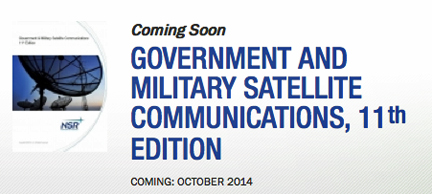
[SatNews] “In today’s connected world, demand for ubiquitous communications will only intensify.”
NSR’s newly released Government and Military Satellite Communications, 11th Edition, report forecasts the global government and military market will demand nearly 700 traditional FSS transponders and 75Gbps of HTS capacity by 2023, generating more than $7.8 billion in annual retail revenues.
Increasing demand from current users, coupled with new customers and evolving bandwidth-hungry applications, will drive this resurgence in a market that has seen declining revenues in 2013 and H1 2014.
In 2013, the U.S. withdrawal from Afghanistan and sequestration-induced budget cuts pinched the commercial SATCOM industry from both sides of procurement: total capacity demand and revenue per unit/transponder. Yet demand for SATCOM capacity remains high, steering NSR to forecast a return to overall market growth by the end of 2016.
“In today’s connected world, demand for ubiquitous communications will only intensify,” said Brad Grady, NSR Senior Analyst and report co-author. “The military’s focus on mobility applications, especially using UAVs and manned aeronautical platforms for ISR missions, will boost demand for both FSS and HTS COMSATCOM capacity. Revenues from various mobility applications will represent 90 percent of the managed service market and 50 percent of leased capacity totals over the next decade.”
Simultaneously, government and military agencies are expected to gradually transition to greater use of Ka-band, X-band, and HTS capacity as an alternative to C- and Ku-band. These more available, secure, or cost-effective services will address current operating constraints and complement government assets. Carolyn Belle, NSR Analyst and report co-author, said, “Governments will be more reliant on their own MILSATCOM satellites moving forward, but they lack sufficient capacity to meet demand—compatible commercial capacity will remain a necessary component of solving that disparity. Current conversations about how to reform commercial procurement practices, and the balance between commercial bulk leasing and end-to-end managed services, are critical elements moving forward.”
Even as more countries launch their own dedicated communications satellites, NSR sees a widening role for commercial satellites in addressing government demand. Operators and service providers are already directing attention to markets beyond the United States to compensate for declining business in this traditionally core market, as well as to providing flexible solutions that will appeal to agencies acting with limited procurement dollars in the near-term. As governments look to get the most for their money, operators and service providers will be pushed to provide cost-effective, comprehensive services.
Information regarding this NSR report may be gleaned at this infopage.

